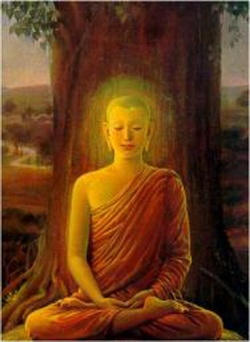Difference between revisions of "Kaccānagotta Sutta"
| Line 1: | Line 1: | ||
[[File:77955.jpg|thumb|250px|]] | [[File:77955.jpg|thumb|250px|]] | ||
| − | The ''Kaccānagotta Sutta'' is a short, but seminal Buddhist text preserved in Pāli (''Saṃyutta Nikāya'' 12.15), Sanskrit, and Chinese (''Samyuktāgama'' 301). The Chinese translation was carried out by [[Gunabhadra|Guṇabhadra]], ca. 435-443 CE as part of a ''[[Āgama|Samyuktāgama]]'' (雜阿含經) translation. A Sanskrit text, also part of the ''Samṃyuktāgama'' and dating from the 13th or 14th century, is preserved. The text is cited in Sanskrit in works by [[Nagarjuna|Nāgārjuna]] and his commentators. There is considerable agreement across the various versions with the Sanskrit and Chinese being more or less identical and both a little different from the Pāli. Nāgārjuna's citation suggests he had a different version from the extant Sanskrit. | + | The ''[[Kaccānagotta Sutta]]'' is a short, but seminal [[Buddhist text]] preserved in [[Pāli]] (''[[Saṃyutta Nikāya]]'' 12.15), [[Sanskrit]], and {{Wiki|Chinese}} (''[[Samyuktāgama]]'' 301). The {{Wiki|Chinese}} translation was carried out by [[Gunabhadra|Guṇabhadra]], ca. 435-443 CE as part of a ''[[Āgama|Samyuktāgama]]'' ([[雜阿含經]]) translation. A [[Sanskrit]] text, also part of the ''Samṃyuktāgama'' and dating from the 13th or 14th century, is preserved. The text is cited in [[Sanskrit]] in works by [[Nagarjuna|Nāgārjuna]] and his commentators. There is considerable agreement across the various versions with the [[Sanskrit and Chinese]] being more or less [[identical]] and both a little different from the [[Pāli]]. [[Nāgārjuna's]] citation suggests he had a different version from the extant [[Sanskrit]]. |
==Themes in the Text== | ==Themes in the Text== | ||
| − | Kaccāna asks about the meaning of the phrase 'right-view' (sammadiṭṭhi; Skt. samyagdṛṣṭi; Ch. 正見). | + | [[Kaccāna]] asks about the meaning of the [[phrase]] 'right-view' ([[sammadiṭṭhi]]; Skt. [[samyagdṛṣṭi]]; Ch. [[正見]]). |
| − | The main theme of the text is the avoidance of the extremes 'existence' (Pāli ''atthi'') and 'non-existence' (Pāli ''natthi'') with respect to the world (Pāli ''loka''), and instead seeing the world in terms of the [[Middle Way]] which is illustrated by the [[Twelve Nidanas|twelve nidānas]]. The one with right-view understands this. | + | The main theme of the text is the avoidance of the [[extremes]] '[[existence]]' ([[Pāli]] ''[[atthi]]'') and '[[non-existence]]' ([[Pāli]] ''[[natthi]]'') with [[respect]] to the [[world]] ([[Pāli]] ''[[loka]]''), and instead [[seeing]] the [[world]] in terms of the [[Middle Way]] which is illustrated by the [[Twelve Nidanas|twelve nidānas]]. The one with right-view [[understands]] this. |
| − | In Chinese the words existence and non-existence are rendered 有 yǒu and 無 wú. The Sanskrit text uses ''asti'' and ''nāsti''. Nāgārjuna's Sanskrit citation uses the words ''bhava'' and ''abhava'' instead, though in the context these terms mean more or less the same as the roots of both ''atthi'' (Sanskrit ''asti'') and ''bhava'' come from verbs meaning 'to be' (i.e. √''as'' and √''bhū''). | + | In {{Wiki|Chinese}} the words [[existence]] and [[non-existence]] are rendered 有 yǒu and [[無]] wú. The [[Sanskrit]] text uses ''[[asti]]'' and ''[[nāsti]]''. [[Nāgārjuna's]] [[Sanskrit]] citation uses the words ''[[bhava]]'' and ''[[abhava]]'' instead, though in the context these terms mean more or less the same as the [[roots]] of both ''[[atthi]]'' ([[Sanskrit]] ''[[asti]]'') and ''[[bhava]]'' come from verbs meaning 'to be' (i.e. √''as'' and √''[[bhū]]''). |
| − | The question of existence and non-existence is discussed in the context of [[Noble_Eightfold_Path#Right_view|right-view]] (''sammādiṭṭhi'') with Kaccāna initially asking the Buddha to define right view for him. | + | The question of [[existence]] and [[non-existence]] is discussed in the context of [[Noble_Eightfold_Path#Right_view|right-view]] (''[[sammādiṭṭhi]]'') with [[Kaccāna]] initially asking the [[Buddha]] to define [[right view]] for him. |
| − | [[Katyayana|Kaccāna]] is a moderately prominent character in the Pāli Canon, and two canonical commentaries are attributed to him. | + | [[Katyayana|Kaccāna]] is a moderately prominent [[character]] in the [[Pāli Canon]], and two [[Wikipedia:canonical|canonical]] commentaries are attributed to him. |
==Sources== | ==Sources== | ||
===Primary=== | ===Primary=== | ||
| − | *Pāli: ''Saṃyutta Nikāya'' (SN 12.15, PTS iii.16-17); also cited in toto in SN 22.90. | + | *[[Pāli]]: ''[[Saṃyutta Nikāya]]'' (SN 12.15, PTS iii.16-17); also cited in toto in SN 22.90. |
| − | *Sanskrit: Sūtra 19 of ''Nidānasaṃyukta'', in a ''Saṃyuktāgama'' collection found in {{Wiki|Turfan}}, probably copied ca. 13th or 14th century.< | + | *[[Sanskrit]]: [[Sūtra]] 19 of ''Nidānasaṃyukta'', in a ''[[Saṃyuktāgama]]'' collection found in {{Wiki|Turfan}}, probably copied ca. 13th or 14th century.< |
| − | *Chinese: ''Samyuktāgama'' 301 (T. 2.99 85a-86c). | + | *{{Wiki|Chinese}}: ''[[Samyuktāgama]]'' 301 (T. 2.99 85a-86c). |
===Secondary=== | ===Secondary=== | ||
[[File:937.jpg|thumb|250px|]] | [[File:937.jpg|thumb|250px|]] | ||
| − | The ''sutta'' is quoted in the [[Lankavatara Sutra|Laṅkāvatāra Sūtra]] (Section LXII; p. 145). It is also cited in Sanskrit in Nāgārjuna's [[Mulamadhyamakakarika|Mūlamadhyamakakārika]] (MMK 15.7) and in commentaries on this work by [[Candrakirti|Candrakīrti]], namely ''[[Prassanapadā]]'' and ''[[Madhyamakāvatārabhāṣya]]''. | + | The ''[[sutta]]'' is quoted in the [[Lankavatara Sutra|Laṅkāvatāra Sūtra]] (Section LXII; p. 145). It is also cited in [[Sanskrit]] in [[Nāgārjuna's]] [[Mulamadhyamakakarika|Mūlamadhyamakakārika]] (MMK 15.7) and in commentaries on this work by [[Candrakirti|Candrakīrti]], namely ''[[Prassanapadā]]'' and ''[[Madhyamakāvatārabhāṣya]]''. |
| − | As the only text cited by name in MMK it is pointed to as evidence that [[Nāgarjuna]] might not have been a Mahāyānist. [[David Kalupahana]] has referred to the MMK as "a commentary on the ''Kaccānagotta Sutta''". | + | As the only text cited by [[name]] in MMK it is pointed to [[as evidence]] that [[Nāgarjuna]] might not have been a [[Mahāyānist]]. [[David Kalupahana]] has referred to the MMK as "a commentary on the ''[[Kaccānagotta Sutta]]''". |
==English Translations== | ==English Translations== | ||
| − | ===from Pāli=== | + | ===from [[Pāli]]=== |
| − | *''Access to Insight'': [http://www.accesstoinsight.org/tipitaka/sn/sn12/sn12.015.than.html Thanissaro], [http://www.accesstoinsight.org/tipitaka/sn/sn12/sn12.015.wlsh.html Walsh]. | + | *''Access to [[Insight]]'': [http://www.accesstoinsight.org/tipitaka/sn/sn12/sn12.015.than.html Thanissaro], [http://www.accesstoinsight.org/tipitaka/sn/sn12/sn12.015.wlsh.html Walsh]. |
*Jayarava. ''[http://www.jayarava.org/texts/kaccanagottasuttam-landscape.pdf Kaccānagotta Sutta] (SN 12.15, PTS S ii.16.) along with Buddhaghosa’s commentary (PTS SA ii.32)''. | *Jayarava. ''[http://www.jayarava.org/texts/kaccanagottasuttam-landscape.pdf Kaccānagotta Sutta] (SN 12.15, PTS S ii.16.) along with Buddhaghosa’s commentary (PTS SA ii.32)''. | ||
| − | *Piya Tan. Kaccā(ya)na.gotta Sutta. ''[http://dharmafarer.org/wordpress/wp-content/uploads/2009/12/6.13-Kaccanagotta-S-s12.15-piya.pdf Dharmafarers]''. | + | *[[Piya Tan]]. Kaccā(ya)na.gotta [[Sutta]]. ''[http://dharmafarer.org/wordpress/wp-content/uploads/2009/12/6.13-Kaccanagotta-S-s12.15-piya.pdf Dharmafarers]''. |
| − | ===from Chinese=== | + | ===from {{Wiki|Chinese}}=== |
| − | *Choong Mun-keat & Piya Tan (2004) | + | *Choong Mun-keat & [[Piya Tan]] (2004) ‘[[Saṃyukta Āgama]] 301 = [[Taishō]] 2.99.85c-86a’. ''[http://dharmafarer.org/wordpress/wp-content/uploads/2009/12/6.13a-Sa-301-Kaccayanagotta-S-rev.pdf Dharmafarer]''. (pages numbered 89-91) |
*Jayarava. [http://www.jayarava.org/texts/Katyayana-Gotra-Sutra.pdf Kātyāyana Gotra Sūtra]. | *Jayarava. [http://www.jayarava.org/texts/Katyayana-Gotra-Sutra.pdf Kātyāyana Gotra Sūtra]. | ||
*LapisLazuli Translations - [[http://en.wikisource.org/wiki/Sa%E1%B9%83yukt%C4%81gama_301:_K%C4%81ty%C4%81yana Wikisource]] | *LapisLazuli Translations - [[http://en.wikisource.org/wiki/Sa%E1%B9%83yukt%C4%81gama_301:_K%C4%81ty%C4%81yana Wikisource]] | ||
==External Sources== | ==External Sources== | ||
| − | *Kalupahana, David J. (1986). ''Nāgārjuna: The Philosophy of the Middle Way''. State University of New York Press. | + | *[[Kalupahana]], David J. (1986). ''[[Nāgārjuna]]: The [[Philosophy]] of the [[Middle Way]]''. {{Wiki|State University of New York Press}}. |
| − | *Li, Shenghai. ''Candrakīrti’s Āgama: A Study of the Concept and Uses of Scripture in Classical Indian Buddhism''. [PhD Thesis]. 2012. | + | *Li, Shenghai. ''[[Candrakīrti’s]] [[Āgama]]: A Study of the {{Wiki|Concept}} and Uses of [[Scripture]] in Classical [[Indian Buddhism]]''. [PhD {{Wiki|Thesis}}]. 2012. |
| − | *Mattia Salvini. 'The Nidānasamyukta and the Mūlamadhyamakakārikā: understanding the Middle Way through comparison and exegesis.' ''Thai International Journal of Buddhist Studies'' II (2011): 57-95. | + | *Mattia Salvini. 'The Nidānasamyukta and the [[Mūlamadhyamakakārikā]]: [[understanding]] the [[Middle Way]] through comparison and {{Wiki|exegesis}}.' ''[[Thai]] International Journal of [[Buddhist Studies]]'' II (2011): 57-95. |
| − | *Tripāṭhī, Chandra. (Ed.). 'Fünfundzwanzig Sūtras Des Nidānasaṃyukta' in ''Sanskrittexte aus den Turfanfunden'' (Vol. VIII). Edited by Ernst Waldschmidt. Berlin: Akademie-Verlag, 1962. [Includes translation into German] | + | *Tripāṭhī, [[Chandra]]. (Ed.). 'Fünfundzwanzig [[Sūtras]] Des Nidānasaṃyukta' in ''Sanskrittexte aus den Turfanfunden'' (Vol. VIII). Edited by Ernst Waldschmidt. {{Wiki|Berlin}}: Akademie-Verlag, 1962. [Includes translation into {{Wiki|German}}] |
| − | *Vaidya, P. L. ''Saddharma-laṅkāvatāra Sūtram''. The Mithila Institute of Post-Graduate Studies and Research in Sanskrit Learning. Darbhanga. 1963. | + | *Vaidya, P. L. ''Saddharma-laṅkāvatāra Sūtram''. The [[Mithila]] Institute of Post-Graduate Studies and Research in [[Sanskrit]] {{Wiki|Learning}}. Darbhanga. 1963. |
{{W}} | {{W}} | ||
[[Category:Saṃyutta Nikāya]] | [[Category:Saṃyutta Nikāya]] | ||
Revision as of 11:27, 3 April 2014
The Kaccānagotta Sutta is a short, but seminal Buddhist text preserved in Pāli (Saṃyutta Nikāya 12.15), Sanskrit, and Chinese (Samyuktāgama 301). The Chinese translation was carried out by Guṇabhadra, ca. 435-443 CE as part of a Samyuktāgama (雜阿含經) translation. A Sanskrit text, also part of the Samṃyuktāgama and dating from the 13th or 14th century, is preserved. The text is cited in Sanskrit in works by Nāgārjuna and his commentators. There is considerable agreement across the various versions with the Sanskrit and Chinese being more or less identical and both a little different from the Pāli. Nāgārjuna's citation suggests he had a different version from the extant Sanskrit.
Themes in the Text
Kaccāna asks about the meaning of the phrase 'right-view' (sammadiṭṭhi; Skt. samyagdṛṣṭi; Ch. 正見).
The main theme of the text is the avoidance of the extremes 'existence' (Pāli atthi) and 'non-existence' (Pāli natthi) with respect to the world (Pāli loka), and instead seeing the world in terms of the Middle Way which is illustrated by the twelve nidānas. The one with right-view understands this.
In Chinese the words existence and non-existence are rendered 有 yǒu and 無 wú. The Sanskrit text uses asti and nāsti. Nāgārjuna's Sanskrit citation uses the words bhava and abhava instead, though in the context these terms mean more or less the same as the roots of both atthi (Sanskrit asti) and bhava come from verbs meaning 'to be' (i.e. √as and √bhū).
The question of existence and non-existence is discussed in the context of right-view (sammādiṭṭhi) with Kaccāna initially asking the Buddha to define right view for him.
Kaccāna is a moderately prominent character in the Pāli Canon, and two canonical commentaries are attributed to him.
Sources
Primary
- Pāli: Saṃyutta Nikāya (SN 12.15, PTS iii.16-17); also cited in toto in SN 22.90.
- Sanskrit: Sūtra 19 of Nidānasaṃyukta, in a Saṃyuktāgama collection found in Turfan, probably copied ca. 13th or 14th century.<
- Chinese: Samyuktāgama 301 (T. 2.99 85a-86c).
Secondary
The sutta is quoted in the Laṅkāvatāra Sūtra (Section LXII; p. 145). It is also cited in Sanskrit in Nāgārjuna's Mūlamadhyamakakārika (MMK 15.7) and in commentaries on this work by Candrakīrti, namely Prassanapadā and Madhyamakāvatārabhāṣya.
As the only text cited by name in MMK it is pointed to as evidence that Nāgarjuna might not have been a Mahāyānist. David Kalupahana has referred to the MMK as "a commentary on the Kaccānagotta Sutta".
English Translations
from Pāli
- Access to Insight: Thanissaro, Walsh.
- Jayarava. Kaccānagotta Sutta (SN 12.15, PTS S ii.16.) along with Buddhaghosa’s commentary (PTS SA ii.32).
- Piya Tan. Kaccā(ya)na.gotta Sutta. Dharmafarers.
from Chinese
- Choong Mun-keat & Piya Tan (2004) ‘Saṃyukta Āgama 301 = Taishō 2.99.85c-86a’. Dharmafarer. (pages numbered 89-91)
- Jayarava. Kātyāyana Gotra Sūtra.
- LapisLazuli Translations - [Wikisource]
External Sources
- Kalupahana, David J. (1986). Nāgārjuna: The Philosophy of the Middle Way. State University of New York Press.
- Li, Shenghai. Candrakīrti’s Āgama: A Study of the Concept and Uses of Scripture in Classical Indian Buddhism. [PhD Thesis]. 2012.
- Mattia Salvini. 'The Nidānasamyukta and the Mūlamadhyamakakārikā: understanding the Middle Way through comparison and exegesis.' Thai International Journal of Buddhist Studies II (2011): 57-95.
- Tripāṭhī, Chandra. (Ed.). 'Fünfundzwanzig Sūtras Des Nidānasaṃyukta' in Sanskrittexte aus den Turfanfunden (Vol. VIII). Edited by Ernst Waldschmidt. Berlin: Akademie-Verlag, 1962. [Includes translation into German]
- Vaidya, P. L. Saddharma-laṅkāvatāra Sūtram. The Mithila Institute of Post-Graduate Studies and Research in Sanskrit Learning. Darbhanga. 1963.

